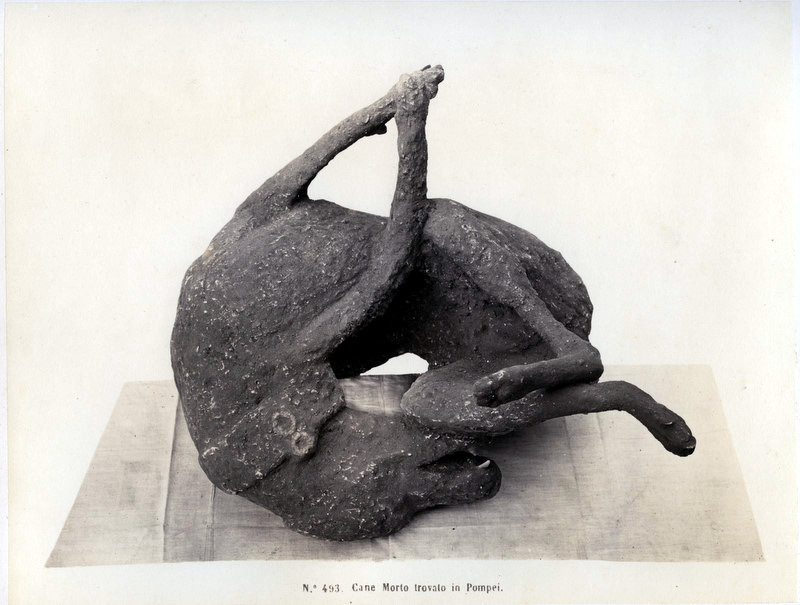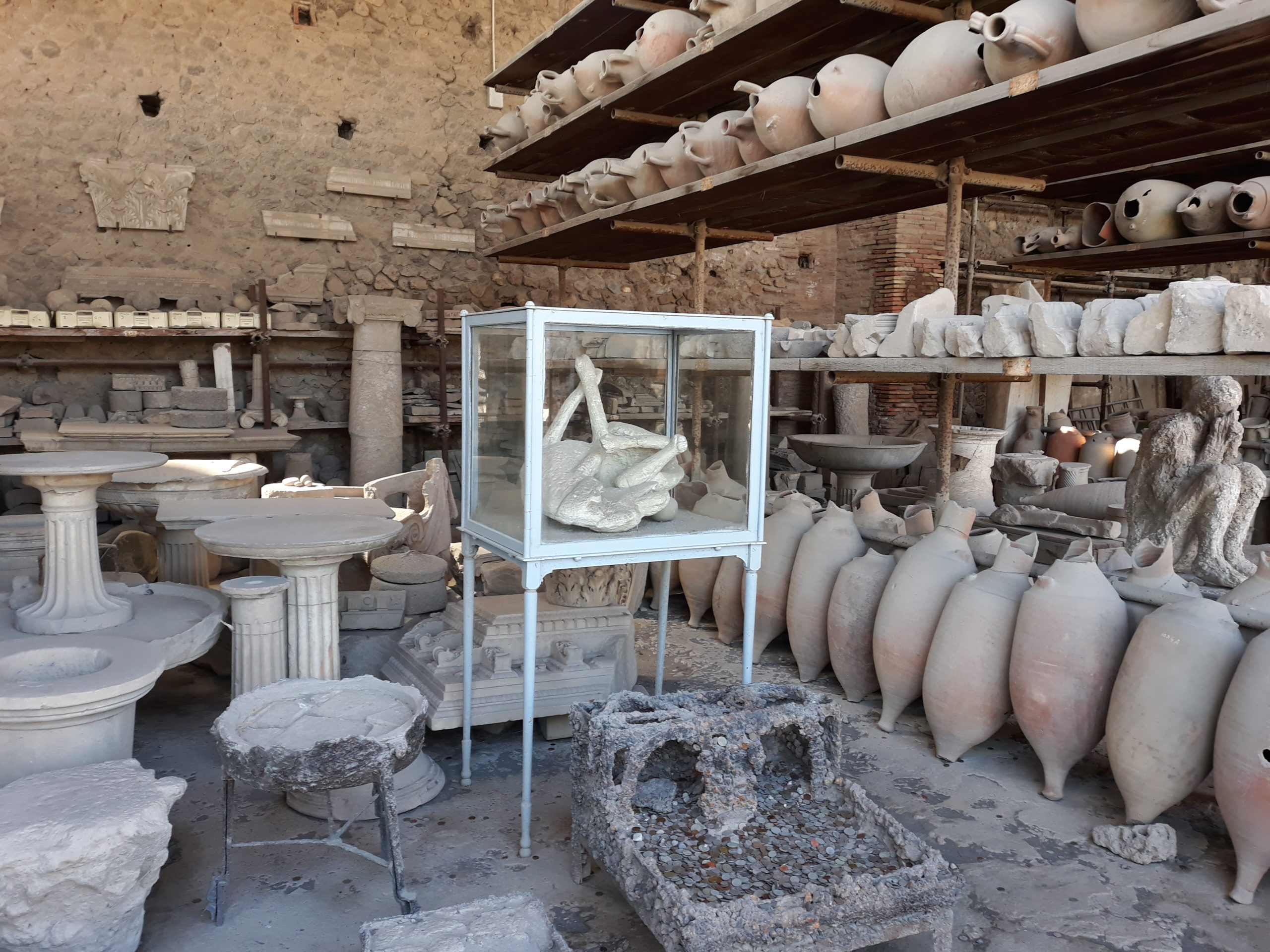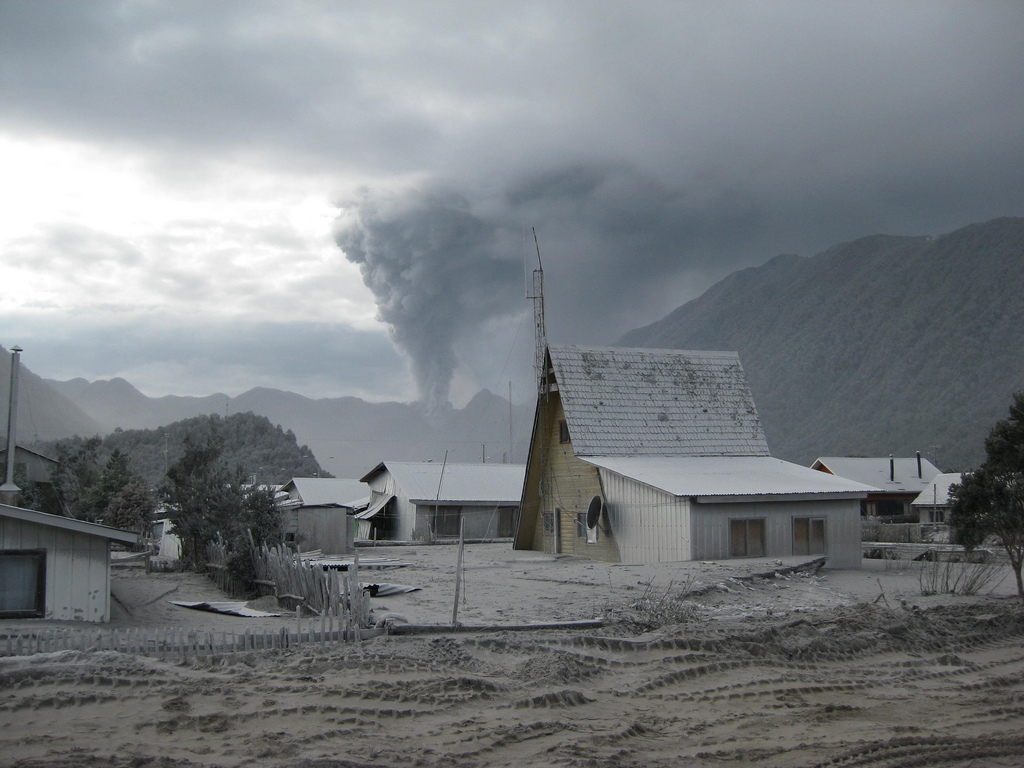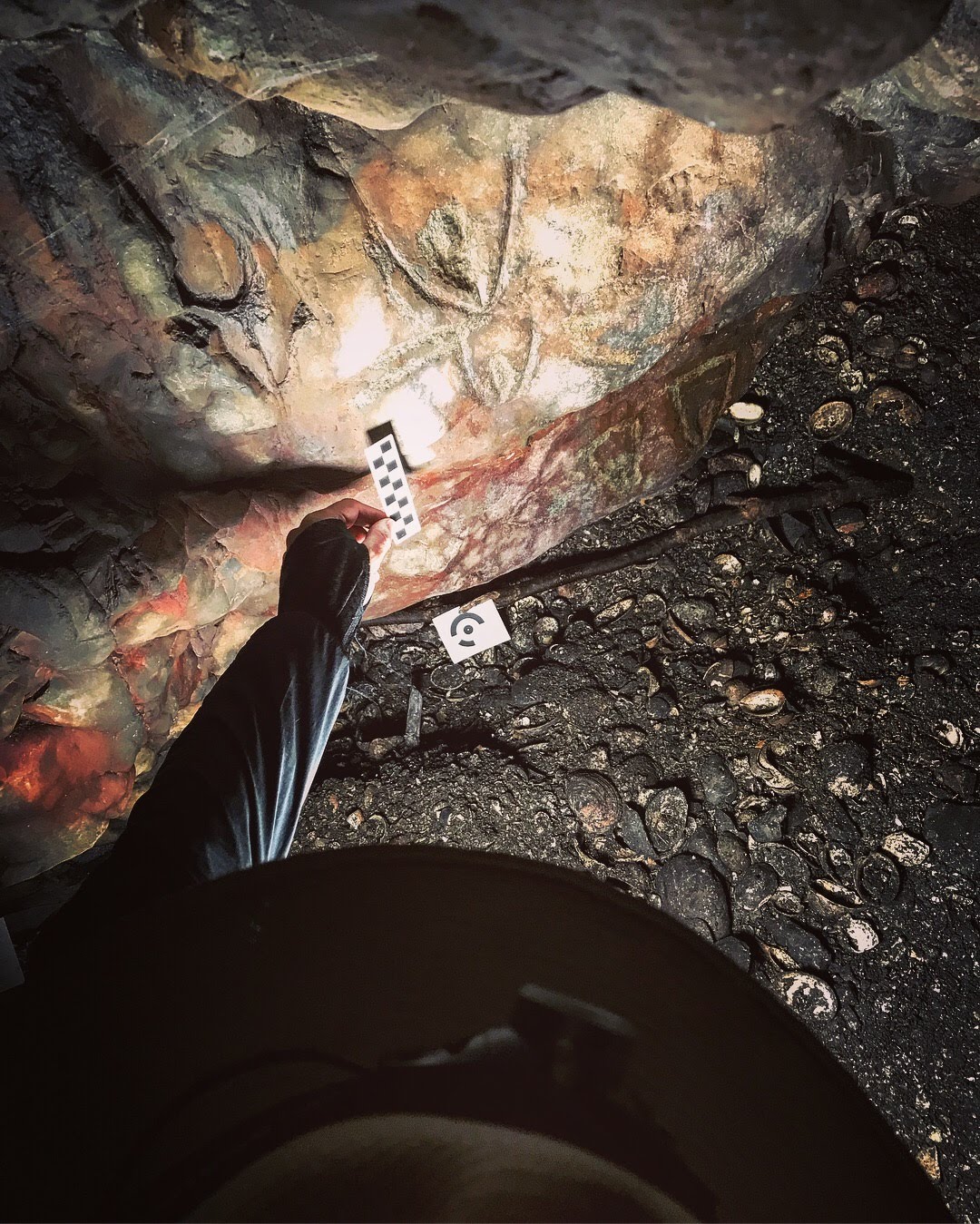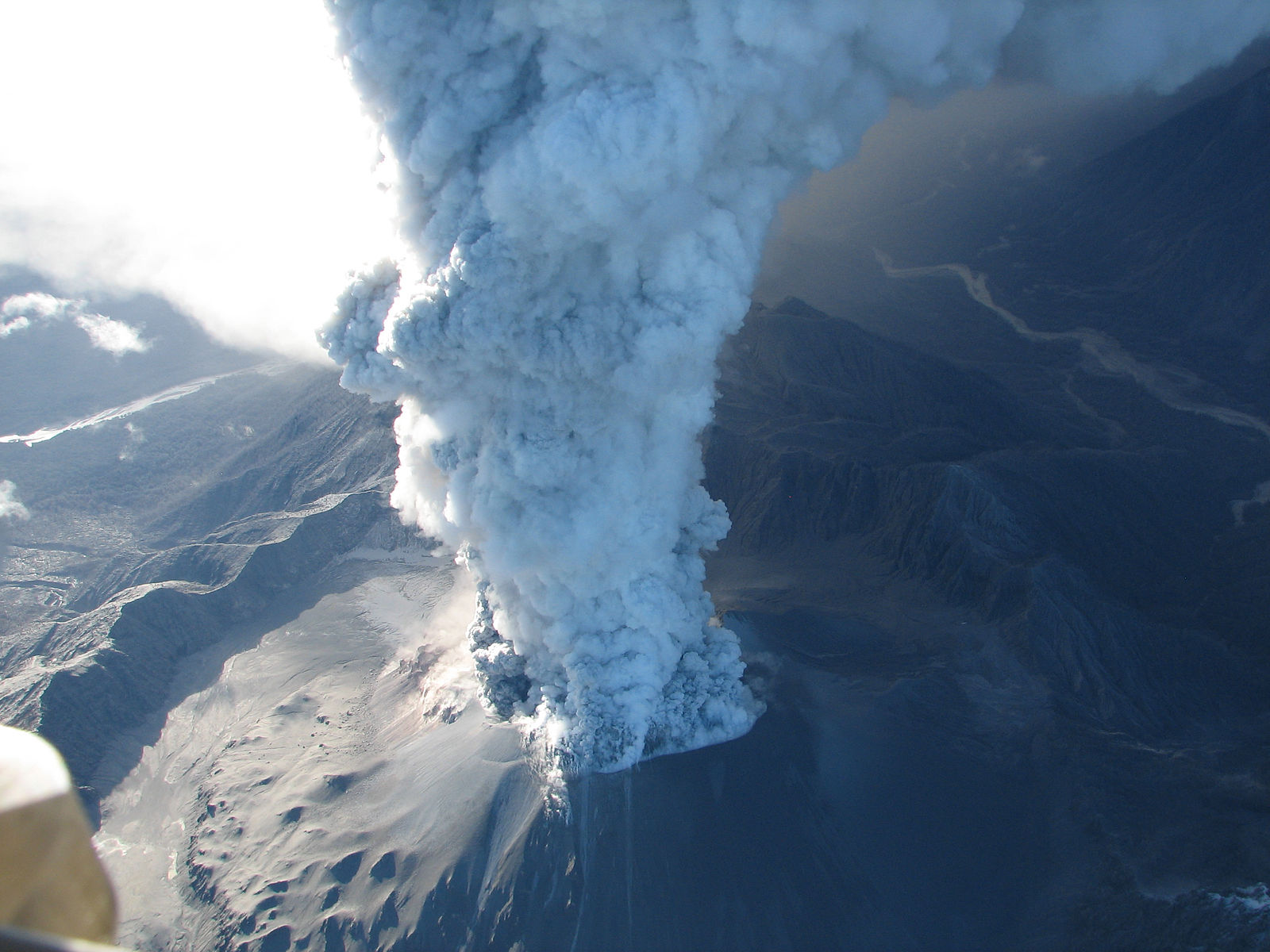Karen Holmberg: Archaeology in an Emergency
Share:
A dead dog found in Pompeii, 1889 [photo: Roberto Rive; courtesy of Wikimedia Commons]
It’s very hard to place Karen Holmberg. She is an archaeologist and a volcanologist, but her practice emanates well beyond the parameters of science and academia. She collaborated with artist Caitlin Berrigan in Berrigan’s exhibition Imaginary Explosions at Art in General in 2019, and she is participating in the Critical Zones exhibition at ZKM Center for Art and Media in Karlsruhe, curated by Bruno Latour (on view through August 2021). Holmberg considers art, performance, film, and literature to constitute a remedy to the anti-science forces at work in society today, as well as a salve for a population fatigued by a barrage of environmental indicators that are just too monumental to get one’s head around. In Part One of this two-part conversation, we discuss Holmberg’s fascination with volcanoes and her discovery of mysterious “spider vulva” petroglyphs, and we consider whether these images can still speak to us.
Will Corwin: When did you first begin to think about volcanoes? When did they enter your consciousness?
Karen Holmberg: I feel a sense of love for volcanoes. There’s a passion and a draw that they have for me—and they always have had since I was a small child—that’s considered antithetical, certainly, to the sciences, in that you’re supposed to be dispassionate, even within archaeology. As a child I found a book that my father had been gifted for Christmas, in 1942, called Richard Halliburton’s Complete Book of Marvels. I grew up in the rural south—a book transported me all over the world. Richard Haliburton was this adventurer from Tennessee. He was extremely popular.
He was gay. That was not something you could pull off easily at that time … and he just had this desire to go and see and do things like Mount Everest. He went everywhere you can possibly imagine. When I read his piece about Pompeii—I must have been maybe seven at the time—that was it. From that moment on it was volcanoes, and it was archaeology, and it was both of those things. It wasn’t, I’m going to be a straight-up archaeologist and look at ceramic shards from this one window of time, or one geographic area, and it wasn’t just I’m going to study degassing in a very particular kind of Earth system, with vulcanology, it was the conjunction of the two.
WC: What was it about Pompeii specifically that jumped out at you?
KH: It’s the same thing that everyone has always gotten out of Pompeii, which is this sense of the uncanny. You’re not supposed to see things from the deep past, looking as though somebody might come back and pick up that loaf of bread. You’re not supposed to be able to walk into a house and see all of the items that somebody used. There’s a sense of tragedy, and of empathy. If you look at Allan McCollum’s work The Dog from Pompei, he cast the dog that was chained outside of a house. [Pompeii] was kind of like the Hamptons in that it was a resort town for wealthy Romans. The season had just ended, so a lot of the wealthy elites who used it as a resort town had already left, so [it was] largely [enslaved people] and servants, and a dog, left to defend things. That dog being chained outside of the house to protect it and just left vulnerable, dying in agony—you can see the agony in the face of this dog. So Alan created dozens and dozens of these dogs. There’s a sense of empathy that you get for past suffering. You know that [the] dog’s suffering ended two millennia ago, and yet it’s conveyed to you in a visceral way. I think that’s why people are always so drawn to the graffiti. It’s very basic things—it’s not just political slogans: you get quite a window into people’s thoughts and memories.
I think that if the wealthy had died, it would be recorded differently. It wasn’t the high season of the year for the wealthy seasonal residents to be there, and they also got up and left when they were, like, “Something’s going funny here.” Because you had two days of the ash falling and the earthquakes going, where you could just walk out, no problem, like you walk through snow, right?
WC: Then no one went back in boats, just to see what was left?
KH: It was covered, and people began farming over that property …. You know, small-scale farming.
WC: Was it ever repopulated the way it had been?
KH: No, and they forgot that those towns were there. There were many beautiful, wealthy enclaves for people to build their new summer houses. Also, with all the seismic activity that happened, there were very popular thermal baths. Basically once the hot water got turned off, once the fault system shifted, there was no reason for that [place]. If you’re going to a particular area for the spa, and the spa waters that it’s known for dry up, you’re not going to go there anymore—everything just shifted. But no, no memorials, it was very quickly [snaps fingers]. It’s sort of insulting. It is a much more important town…—
WC: —We’re more concerned with Pompeii now.
KH: Yes, it is much more important to Western, contemporary … thought than it ever was in the Roman era. It really has shaped the way that we think of nature and culture intersecting, because you have this monument, Vesuvius, looming over the town, and it’s sort of culture endangered by nature, which is completely inappropriate in the 21st century now. We’ve flipped that. We are the volcano in a sense, we are imperiling nature. So that’s a huge rethinking.
A collection of ancient ruins of Pompeii, Italy [photo: Simon Burchell; courtesy of Wikimedia Commons]
WC: I wanted to ask you more philosophical questions about contemporary archaeology and your interdisciplinary methodology. Reading your reports and articles, there’s a different approach than the typical one in archaeology. You refer to Kant and Kiran Desai. You integrate a lot of semiotics and philosophy in your interpretations. Where did this interest in expanding the field of archaeology come from, and was this a wall you began to butt up against when you were studying?
KH: I’m not some superhero anomaly in the field, in that there are tremendous ranges in how people approach archaeology and what they do with it. There was some classic statement that was made by a woman archaeologist—probably the 80s—where she was being attacked for having tried to broaden the scope and not do just the same standard approaches. Somebody had said, “This isn’t archaeology,” and she defended herself [by] saying, “You know what archaeology is? Archaeology is what archaeologists do.” There was a growing move to deal with more philosophical components of archaeology that was set in motion with the same thing that was happening everywhere with the post-modern movement, but it got called post-processual in archaeology.
The processual movement was this revolution in the 1960s and 1970s to try and make archaeology into a hard science, a true science where you have a white lab coat, and so there was an almost anti-science backlash with the post-processual movement where you could all of a sudden be quoting Kant and not be seen as outside. It was more Derrida and Foucault, like everyone else at that point, but I guess just to say that archaeology is no one thing, no one standard methodology necessarily. That said, I pulled out of academia, in 2011, after teaching at Stanford … to do other things, because I felt very confined by what was going to be expected of me if I wanted to do the tenure-track for an archaeology job.
Gallatin School at NYU is the interdisciplinary school of NYU, and that’s the right sort of place for me, in that what I’m doing; it’s not straight-up archaeology at all. I’m interested in drawing in the history of science, components that are not straight-up field archaeology, and [I’m] interested in drawing in the creative and artistic discussions. All that’s to say, it’s not like I’m some kind of revolutionary—I don’t fit the standard mold.
WC: The cave remains that you found at Chaiten, how did those relate to the volcanic action nearby? Is there a direct correlation?
KH: In 2008 the Chaiten volcano erupted unexpectedly: people were not aware that it was a volcano until it went off. It was the largest evacuation in Chile’s history, and they got the entire town out within two days. Chaiten has been erupting—and I love this phrase—“continuously but intermittently,” for the last 18,000 years. People have been in this area for thousands of years; it’s not far from Monte Verde. They would have been aware of these eruptions that had been occurring, but they weren’t living there in large population numbers or permanently. These were maritime people who were coming and going in canoes. The radiocarbon dates from this last stint of fieldwork push the occupation of this cave back at least 2,000 years from the stratiagraphic levels that we accessed. If we go farther into the caves, I have a sneaking suspicion the people could have been using them as early as 6,000 years ago.
The eruption of Chaiten, 2008 [photo: Javier Rubilar; courtesy of Wikimedia Commons]
WC: Describe the site …
KH: You’ve got four caves: The higher cave has the older dates. Quite clearly there was a ritual component that we’re never going to excavate; you can’t excavate the prehistoric mind. [We are] trying to figure out why some caves have no art in them but do have shell middens. Why are there other forms of art: You’ve got a mix of painted designs and etched designs? Something was going on: At the opening of the cave you’ve got these red dots and red lines that have been painted, and one image that looks like a sun. Once you go to the internal parts, the more private portions of the cave, that’s where you find the vulvas—this entire panel of [etched] vulvas of different sizes. It’s very distinctive that the ceilings of these caves are absolutely covered in spiders and this rare blind cricket that’s found very few places in the world. And the fact that one of these vulvas has become this vulva-spider hybrid is interesting to me from that perspective.
WC: Were they living in these spaces?
KH: I don’t think you’d be living in this space.
WC: And the vulvas, do they have a link to a specific ritual do you think?
KH: There is a gender component to a cave. Is this a very female space because you’ve got vulvas on the wall, and there’s some kind of association potentially with childbirth or fertility? The vulva design shows a potential linkage to the Mapuche indigenous group, in Patagonia; they’re on the other side of the mountain range.
WC: The link is historic?
KH: Iconographic—there are other caves in Patagonia with the red handprints, but for this area, this is completely unexpected; much farther south you would expect to see this [cave decoration/imagery]. It seems that people would have been coming from the coastline, stopping off for a short time, having meals.
WC: Who discovered these caves? Were the caves known to the current inhabitants at Chaiten?
KH: These were not known until the resettlement: The volcano erupted in May 2008, everyone had to leave, and they left in a rush. You had to leave most of your belongings, your animals, etc., behind. People were sneaking back, past police checkpoints, to check on their belongings, check on animals. When people were being resettled, the government said we’re going to put people in a different location, because you’re in the line of fire again for the next time there’s volcanic activity.
WC: But they want to go back?
KH: They wanted to go back; from a cultural perspective, they wanted to be where their grandparents had built, by hand, the house they grew up in. They felt that linkage. But in the process of surveying the area called Santa Barbara, these caves were discovered. People started visiting them piecemeal, taking tourists up for money, sort of an under the wire thing. By about 2010–2011, people knew about these caves. The municipality knows they need to do something about protecting the caves. I didn’t even know they were being used for raves until we needed some volunteers at the very end of our field work, and some people who came to help us were like, “Oh yeah!” And I was like, “Oh dear god, really?” I was cringing. But you get it, there is something special that you can feel, when you’re inside a cave.
In all caves, if you go in alone and are quiet, and just feel the earth, there is a resonance: You don’t have to have any rock art there. What was the rock art for, then? Was it meant to accentuate that feeling that’s already there when you’re within the Earth? Was it a commemoration of that feeling? Were you trying to heighten it even more, [the way] they are in these raves in the middle of the night, with the laser-lights and the music? I don’t know.
Spider Vulva from cave in Chaiten [photo: Karen Holmberg]
WC: That was something Jill Cook brought up in my interview with her, that some of the caves are chosen because they are mystical locations within the mythology and ritual of the culture. That may account for why some are decorated and some are not.
KH: The cave that has the vulvas—you enter … the cave, and it’s wide. Then it narrows and narrows and narrows; and at its most narrow point, just wide enough for a person to walk through, that’s where the vulvas are. And then it opens up—it’s like an hourglass almost. So people who were coming to visit the caves, and the people who were working on the team, spontaneously were like, “Birth canal.”
WC: We don’t have any idea what the spider vulva means, whether it’s a depiction of a deity or an ideograph, but what is a symbol that could you position in contemporary archaeology as an analogue? Is it even possible to draw a comparison?
KH: For that question, I would refer you to this documentary—that I have loved since it first came out—called Into Eternity [Michael Madsen, 2010]. It’s about the Onkalo facility, a repository for nuclear waste, in Finland. How do you mark, how do you create some visual language that’s going to convey something in the deep future to somebody else, who might not even be human? Going through different archaeological analogues, [starting] from ancient Egypt: How do you mark something in a way that’s going to mean something to somebody else? They kind of come up with the fact that you can’t. That meaning doesn’t necessarily convey. Some future archaeologist is just going to want to dig into it if they know it’s there. The best you could possibly do? Hide it and leave it completely unmarked—100% overgrown with trees—so that nobody knows it’s there. That’s the only way. There is no way for meaning to be transportable over time.
WC: Do you get a sense that there are any records in that prehistoric imagery, of something that happened, that they were recording?
KH: No, not at all. I think that record goes into oral history. I think that that’s stories. For me, the rock art that I have experience with seems to have a ritual or an experience. When you’re there, it’s that experience, not, “I’m recording an experience that happened a year ago and I want it here, as sort of a library.” No, I think it’s more about ceremony, potentially, or some kind of communion you’re trying to make with something outside of yourself, whether that’s the cave itself or some kind of life force associated through the earth in the cave. Again, you can’t excavate a cosmology, unfortunately.
WC: And you haven’t come across caves that show they were special in a way that made them a locus for ritual.
KH: That’s why I think the acoustic work is really interesting. The work by Bruno Fazenda with acoustics, and why particular portions of a cave might have art while others don’t, and why particular forms of art—as I mentioned—again, people wanted to be isolated, and alone, and it was the experience. You wanted to be alone and in some remote, inaccessible, and difficult space—and it was a matter itself of creating the art as much as anything else; that experience, that ritual, that ceremony: a very individual one. And then about ten thousand years ago, when people began farming, when people began settling permanently in locations—so you wanted to be in spaces that could hold larger numbers of people, and it could be more of a ceremony that involved performance. Whether that was by clapping or singing or musical instruments. Or whatever it was, there was some kind of experiential thing that wasn’t just for the person creating the art. There was an audience, I guess is what I am saying.
Columns of smoke from the eruption of Chaiten in 2008 [photo: United States Geological Survey; courtesy of Wikimedia Commons]
WC: You’re just about to open a museum chronicling the recent events that have taken place in Chaiten. How do you approach a museum of contemporary archaeology without fetishizing this idea of environmental destruction? How do you create a contemporary archaeological museum that is sensitive to the dangers of making visiting disaster sites, natural and otherwise, too much like a form of entertainment?
KH: Chaiten is actually quite interesting in terms of visiting a contemporary archaeology site. They are trying to preserve these houses that were destroyed by volcanic events, not ash falling or lava flowing, but from the lahar, a mud flow. But at what point do you arrest ruination? It’s an ongoing process, not static in time. It actually takes a lot of work to keep a ruin in one particular stage of ruination. It’s going to inevitably want to continue morphing towards future stages of ruination, and it takes a lot of money. You draw in the narrative voices of the local community and allow them to tell their own stories: collecting their memories, their oral histories. There’s a tremendous amount of art therapy through psychologists at the University of Chile immediately after the initial resettlement of the area, soon after the eruption. It took two years before people were able to move back, and that was part of the trauma: the separation, the dislocation, and the not knowing when it was going to end. Frequently an eruption is not something with a distinct finish. The artwork was collected when they were initially able to return to this completely destroyed community. [Art therapy] was done again just last year. What about children who were too young to remember the initial eruption or children who have been born since? They’re going to have a very different relationship to the destruction, the resettlement, and the renewal. This museum is being created with input from the geological survey in charge of monitoring all of Chile’s volcanoes. The head of that network is himself Mapuche. He’s an internationally renowned scientist; he’s also indigenous, and that gives him a very different relationship to the volcanic landscape.
WC: Did he grow up with different interpretations of volcanoes? Does he voice this?
KH: When an eruption was starting, when he was a child, his grandparents had very different explanations for what was happening than what you’re going to get in a geology textbook. He has a different interpretation of what form of communication is going to be most effective to different audiences. When you’re thinking about conveying risk, and this is something that’s true about volcanic eruption and something that’s true about environmental change—anthropogenic climate change—conveying risk has to be carefully tailored to mean something to your audience. It allows them to have tools to make the decisions they need to make and [decide] what actions they need to take. This is why art is important. Art is essential to convey information outside of the scientific community to the larger population that needs to understand what we’re going through.
This is monumental, what we’re seeing. We’re watching large-scale geological transformations occurring in the human time-frame. We are watching mass extinctions happen in front of our eyes. Radical transformations occurring within very short time periods. How do you grapple with that? Both on a tangible physical level but also on an existential one? It’s something that we’re all struggling with, those of us who are trying to deal with it. It’s also something that a large number of people haven’t even touched—they’re not even aware. How do you deal with responsibly and accurately conveying things that are important, while dealing with your own sense of grief?
Karen Holmberg would like to express immense gratitude to Constanza Gómez, Director of Fundación ProCultura (The ProCultura Foundation), Chile, for her tireless efforts for the Chaiten community and her invaluable role in this project.
Will Corwin is a sculptor and journalist from New York. He has exhibited at The Clocktower, LaMama and Geary galleries in New York, as well as galleries in London, Hamburg, Beijing and Taipei. He has written regularly for Artpapers, The Brooklyn Rail, Bomb, Artcritical and Canvas and formerly for Frieze.
